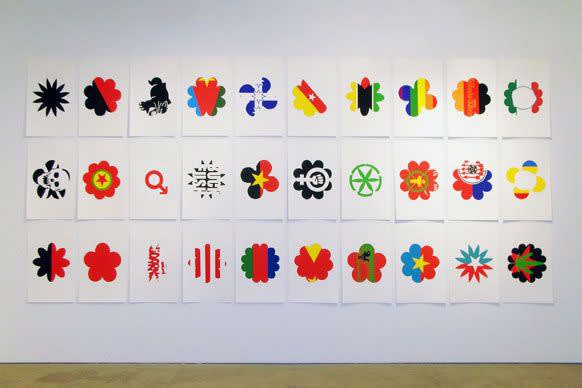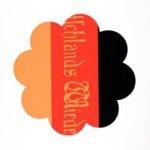It's not always easy to find work of Polly Apfelbaum's that you can take home. Much of her work is installed on gallery floors or draped over ceiling pipes and down walls. Her Haunted House was an actual cabin in the Swiss Alps, without plumbing or electricity, that could only be gotten to by hiking. "I wanted to bring the hillbilly to this pristine alpine location in Switzerland," she said. She left bottles of moonshine in the cabin for visitors who wanted, "the full, hillbilly experience" in the Alps.
Easier to carry home, and less dangerous than moonshine, are the silkscreens that are available in our gallery. They were created for Apfelbaum's Flags of Revolt and Defiance exhibit, on display in 2006 at Columbia University's Leroy Neiman Center for Print Studies Gallery.
Apfelbaum has taken the flags of political and social movements from around the world and placed them inside the pop flower that defines much of her work.
Here's a look at the story behind some of the symbols she used:
- The Sons of Liberty Flag was the symbol of the group that got together in the thirteen American colonies to fight against British rule. In 1773, the Sons of Liberty organized the Boston Tea Party, and the rest is history.
- The official flag of Romania had the communist coat of arms printed in the center yellow band. During the Romanian Revolution in 1989, protestors cut out the coat of arms and waved, what they called, the flag with the hole, a symbol of their wish to do away with the dictatorial regime in power at that time. The Rumanian Uprising flag is Apfelbaum's interpretation of revolutionary flag with the hole.
- The flag of the Kurdistan Worker's Party (PKK) was first waved in Turkey in 1978 to protest the poor treatment of Kurds by the government of Turkey. The PKK has a long and checkered history of struggle against oppression. Many Kurds still live in Turkey, but many have also settled in Syria, Iran, Greece and Cyprus. Apfelbaum has beautifully simplified the flag of a very complex movement.
- Germany has had many flags during its long and changing history, but the flag that heralded the fall of the Berlin wall in 1989, commemorated one of the most exciting moments celebrated around the world. The words, Deutsche Wiedervereinigung (German Reunification), can be seen in Apfelbaum's version of the flag of the Advocates of German Unification.
- One of the best known movements of all time, the Women's Rights Movement, has brought women a long way and is still relevant today. Apfelbaum's spin on the flag of the National Organization of Women (NOW) is a strong, bold statement inside her signature flower.
- The turbulent '60s gave rise to the Yippies, or Youth International Party, known as much for its pranks as its politics. Abbie Hoffman and Jerry Rubin became the most famous leaders of the movement, whose members were sometimes called the Groucho Marxists. Abbie Hoffman wrote that the Yippies wanted to build a nation as rugged as the marijuana leaf, the symbol that graced the Yippies flag. Apfelbaum has gotten the essence of this flag just right.
- Apfelbaum's work can be found in the collections of the Museum of Modern Art, the Whitney Museum of American Art, the Israel Museum and the Yale University Art Gallery.
We feel fortunate to have be able to offer these unique silkscreens, from an artist whose work is always beautiful, thoughtful and playful. See more Polly Apfelbaum prints here.








